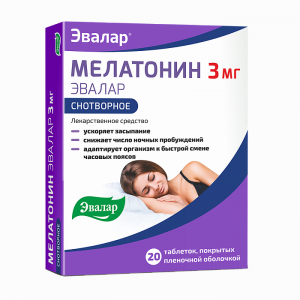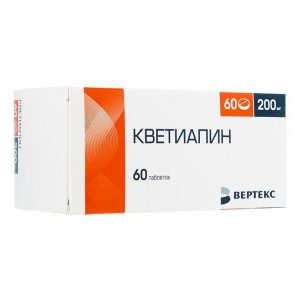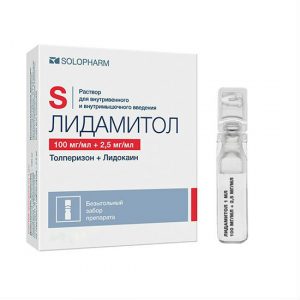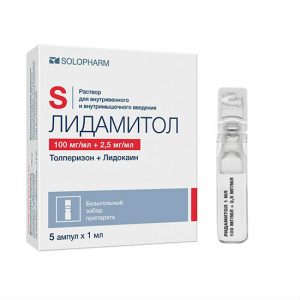Description
Description
Tablets are white or white with a yellowish tint, flat-cylindrical in shape with a bevel and chamfer.
Pharmacological action
Carbamazepine is a derivative of dibenzoazepine and has antiepileptic, neurotropic, psychotropic and antidiuretic effects.
As an antiepileptic, it stabilizes the membranes of overexcited neurons, suppresses serial discharges of neurons and reduces the synaptic transmission of excitatory impulses. This action is achieved, presumably, due to the blockade of sodium channels, as a result of which the re-occurrence of sodium-dependent action potentials in depolarized neurons is prevented. Reduces the release of the neurotransmitter glutamate. The psychotropic effect of carbamazepine is apparently due to inhibition of the exchange of dopamine and norepinephrine.
Reduces seizure frequency, anxiety, depression, irritability and aggressiveness in patients with epilepsy. The effect on cognitive function in patients with epilepsy is variable. Prevents the appearance of paroxysmal pain with neuralgia. In case of alcohol withdrawal syndrome, it increases the threshold of convulsive readiness, reduces increased nervous excitability, tremor, and gait disorders. It is used to treat affective disorders as an antipsychotic and normotimic agent. With diabetes insipidus reduces diuresis and thirst.
Indications
Epilepsy (monotherapy or as part of complex therapy):
– complex and simple partial seizures (with or without loss of consciousness) with or without secondary generalization
– generalized tonic-clonic seizures. Mixed forms of epileptic seizures.
Acute manic conditions and supportive care for bipolar affective disorders to prevent exacerbations or reduce the severity of clinical manifestations.
In the complex treatment of alcohol withdrawal syndrome.
Trigeminal neuralgia (idiopathic, with multiple sclerosis), idiopathic glossopharyngeal neuralgia.
Pain syndrome in diabetic neuropathy.
Polyuria and polydipsia of neurohormonal nature in diabetes insipidus.
Contraindications
Hypersensitivity to any of the components of the
drug renal failure of moderate to severe severity
children under 12 years of age.
Caution:
If you have the following diseases or conditions, you should consult your doctor before using the drug: hypercalcemia, nephrocalcinosis, urolithiasis with the formation of calcium-oxalate stones (see Special Instructions ), congestive heart failure (see Special indications “), hypophosphatemia, including absence in old age with heart, liver or kidney failure, increased intraocular pressure of hyponatremia, dilution of hypothyroidism, prostate hyperplasia of pregnancy (increased risk of development of intrauterine developmental disorders, including malformations).
Directions for use
Inside, regardless of food intake, with a small amount of liquid.
Epilepsy: if possible, carbamazepine should be prescribed as monotherapy. Treatment begins with a small daily dose, which is subsequently slowly increased until the optimal effect is achieved. The addition of carbamazepine to an ongoing antiepileptic therapy should be carried out gradually.
For adults, the initial dose is 100-200 mg 1-2 times a day. Then the dose is slowly increased to 400 mg 2-3 times a day. The maximum daily dose of 2000 mg.
For children under 5 years of age, the initial dose is 20-60 mg per day, increased by 20-60 mg every two days. In children from 5 years old, the initial dose is 100 mg / day, followed by an increase of 100 mg per week. The maintenance dose for children is 10-20 mg / kg body weight per day for 2-3 doses. To ensure accurate dosing, in children under 5 years of age, it is necessary to use liquid oral dosage forms of carbamazepine.
Neuralgia of trigeminal or glossopharyngeal nerves: the initial dose is 200-400 mg / day, then the dose is gradually increased by no more than 200 mg per day until the pain stops (on average, up to 600 – 800 mg), then reduced to the minimum effective dose. In the treatment of elderly patients, the initial dose of 100 mg 2 times a day.
Alcohol withdrawal syndrome: average dose – 200 mg 3 times a day. In severe cases, in the early days, the dose can be increased to 400 mg 3 times a day. At the beginning of treatment for severe withdrawal symptoms, it is prescribed in combination with detoxification therapy, sedatives and sleeping pills.
Polyuria and polydipsia in diabetes insipidus: the average dose for adults is 200 mg 2 to 3 times a day. In children, the dose is selected taking into account body weight and age.
Pain syndrome in diabetic neuropathy: 200 mg 2 to 4 times a day.
Acute manic conditions and supportive care for bipolar affective disorders: daily dose of 400-1600 mg (average daily dose of 200-600 mg) for 2-3 doses per day. In acute cases, the dose is increased quite quickly. With maintenance therapy, the dose increase should be gradual and small.
Special instructions
Before starting treatment, and periodically during the course of treatment, clinical blood tests should be performed (including counting the number of platelets, reticulocytes, as well as the concentration of iron in the blood serum), general urinalysis and determination of the level of urea in the blood. The drug has a weak anticholinergic activity. Therefore, in the case of the use of the drug in patients with increased intraocular pressure, constant monitoring of this indicator is necessary.
Recommended periodic determination of the concentration of carbamazepine in blood plasma in cases of increased incidence of epileptic seizures, in the treatment of children, in pregnant women, if used as part of complex therapy, the development of pronounced side effects.
There are some reports of impaired male fertility and / or impaired spermatogenesis. However, the causal relationship of these disorders with the use of the drug has not yet been proven.
Hypersensitivity cross reactions may occur between carbamazepine and phenytoin or oxcarbazepine.
During the treatment period, it is necessary to refrain from engaging in potentially hazardous activities that require an increased concentration of attention and speed of psychomotor reactions.
It is necessary to stop taking alcohol for the duration of therapy, since carbamazepine enhances the inhibitory effect of alcohol on the central nervous system.
Composition of
One tablet contains:
active substance:
carbamazepine 200 mg
excipients: potato starch – 80.5 mg, colloidal silicon dioxide (aerosil) – 16.4 mg, talc – 3.1 mg, magnesium stearate – 3.1 mg, povidone (polyvinylpyrrolidone) – 14.4 mg, polysorbate (tween-80) – 2.5 mg.
Side effects
Disorders of the nervous system: dizziness, ataxia, drowsiness, tiredness, headache, diplopia, accommodation disturbances, tremors, muscular dystonia, tics, nystagmus, orofacial dyskinesia, oculomotor disturbances, dysarthria choreoathetoid disorders, peripheral neuropathy, paresthesia, paresis, taste disorders, malignant antipsychotic syndrome.
Mental disorders: hallucinations (visual or auditory), depression, anorexia, anxiety, aggressive behavior, agitation, disorientation, increased psychosis.
On the part of the skin and its appendages: allergic dermatitis, urticaria, exfoliative dermatitis, erythroderma, systemic lupus erythematosus, pruritus, Stevens-Johnson syndrome, toxic epidermal necrolysis, photosensitivity reactions, erythema multiforme and nodosum, pigmentation disorders, purpura, acne , hair loss. Rare cases of hirsutism have been reported, but the causal relationship of this complication with the drug remains unclear.
From the hemopoietic system: leukopenia, thrombocytopenia, eosinophilia, leukocytosis, lymphadenopathy, folic acid deficiency, agranulocytosis, aplastic anemia, pancytopenia, anemia, true erythrocytic aplasia, megaloblastic anemia, variegative porphyria, late cutaneous porphyria, acute intermittent hemorrhoids, porphyria.
From the hepatobiliary system: an increase in gamma-glutamine transferase, alkaline phosphatase, transaminase hepatitis (cholestatic, parenchymal (hepatocellular) or mixed type), jaundice, granulomatous hepatitis, liver failure.
From the gastrointestinal tract: nausea, vomiting, dry mouth, diarrhea, constipation, abdominal pain, glossitis, stomatitis, pancreatitis.
Hypersensitivity reactions: delayed multi-organ hypersensitivity with fever, skin rashes, vasculitis, lymphadenopathy, arthralgia, leukopenia, eosinophilia, hepatosplenomegaly and altered indicators of liver function (these manifestations occur in various combinations). Other organs (lungs, kidneys, pancreas, myocardium, colon) may be involved. Aseptic meningitis with myoclonus and eosinophilia anaphylactic reaction, angioedema.
On the part of the cardiovascular system: intracardiac conduction disturbances, decrease or increase in blood pressure, bradycardia, arrhythmia, atrioventricular block with fainting, collapse, congestive heart failure, worsening of coronary heart disease, thrombophlebitis, thromboembolism.
From the endocrine system and metabolism: edema, fluid retention, weight gain, hyponatremia and a decrease in plasma osmolarity due to an effect similar to the action of antidiuretic hormone, which in rare cases leads to water intoxication (dilution hyponatremia), accompanied by lethargy, vomiting, headache, disorientation and neurological disorders, an increase in prolactin level, accompanied or not accompanied by gala a decrease in the concentration of triiodothyronine and thyroxine, an increase in the concentration of thyroid stimulating hormone, which is usually not accompanied by clinical manifestations There are disorders in bone metabolism (a decrease in the concentration of calcium and 25-hydroxycolecalciferol in the blood plasma), which leads to osteomalacia, an increase in the concentration of cholesterol, including high-density lipoprotein cholesterol and triglycerides.
From the genitourinary system: interstitial nephritis, renal failure, albuminuria, hematuria, oliguria, azotemia, frequent urination, urinary retention, sexual dysfunction, impaired spermatogenesis.
On the part of the sensory organs: disturbances in taste, clouding of the lens, increased intraocular pressure, conjunctivitis of hearing impairment.
From the musculoskeletal system: arthralgia, muscle pain, muscle weakness, cramps.
From the respiratory system: hypersensitivity reactions characterized by fever, shortness of breath, pneumonitis or pneumonia.
Change in laboratory test results: hypogammaglobulinemia.
Drug Interactions
Concomitant use with inhibitors of the CYP3A4 isoenzyme can lead to an increase in plasma carbamazepine concentration. The combined use of inducers of the isoenzyme CYP3A4 can lead to an acceleration of the metabolism of carbamazepine and a possible decrease in its concentration in plasma. The cancellation of simultaneously taken inducers of the CYP3A4 isoenzyme can reduce the rate of biotransformation of carbamazepine and lead to an increase in the level of carbamazepine in blood plasma. With simultaneous use with drugs metabolized by the CYP3A4 isoenzyme, metabolic induction and a decrease in their plasma concentration are possible.
Drugs that can increase the concentration of carbamazepine or carbamazepine-10,11-epoxide in plasma:
dextropropoxyphene, ibuprofen, danazole, macrolide antibiotics (e.g. erythromycin, troleandomycin, clarithromycinfetin, clarithromycinone, nephrolithin, paraffin, paraffin), viloxazine, styripentol, vigabatrin, azoles (e.g. itraconazole, ketoconazole, fluconazole, voriconazole), loratadine, terfenadine, loxapine, olanzapine, quetiapine, isoniazid, viral protease inhibitors for the treatment of HIV infection (for example, ritonavir), acetazolamide, verapamil, diltiazem, omeprazole, oxybutynin, dantrolene, ticlopidine, nicotinamide (in adults, only in high doses), possibly cimetidine, desipramine, primidone, valproic acid.
Drugs that can lower the concentration of carbamazepine in plasma:
felbamate, metsuximide, oxcarbazepine, phenobarbital, fenuximide, phenytoin, fosphenytoin, primidone, progabide, theophylline, aminotricin, rosiferin, isotretin, rosin, isofretin, rosin, isotretin, docin, isofretin, rosin, isotretin, docin, isotretin, rosin, isotrebin, data are contradictory, possibly also clonazepam, valproic acid or valpromide.
Effect of carbamazepine on plasma concentrations of drugs used as concomitant therapy:
Carbamazepine can lower plasma concentrations or reduce or even completely level the effects of the following drugs: methadone, paracetamol, antipyrine, tramadol, doxycycline, oral anticoagulants (warfarin, fenprocoumone, dicumarol, imococumarol, bupropion tricodiprazide, cytodiprazide, cytodiprazide, tsitalopradepiodoprazodrazodlipodrazindra amitriptyline, nortriptyline, clomipramine), clobazam, clonazepam, ethosuximide, felbamate, lamotrigine, oxcarbazepine, primidone, tiagabine, topiramate, valproic acid, zonisamide, itraconazole, praziquantel , imatinib, clozapine, galoperidol, bromperidol, olanzapine, quetiapine, risperidone, ziprasidone used in the treatment of HIV infection (indinavir, ritonavir, saquinavir), alprazolam midazolam, theophylline, calcium channel blockers of the dihydropyridine group (e.g. alternative methods of contraception), glucocorticosteroids (e.g. prednisone, dexamethasone) cyclosporine, everolimus, sodium levothyroxine, estrogens and / or progesterone. There are reports that while taking carbamazepine, the level of phenytoin in the blood plasma can either increase or decrease, and the level of mefenitoin can increase (in rare cases).
Combinations to consider:
Isoniazid-induced hepatotoxicity may be increased if used concomitantly with carbamazepine.
In the case of co-administration with levetiracetam, the toxic effect of carbamazepine may be enhanced.
The combined use of carbamazepine and lithium or metoclopramide, as well as carbamazepine and antipsychotics (haloperidol, thioridazine) can lead to an increase in the frequency of undesirable neurological reactions (in the case of the latter combination, even at therapeutic concentrations of active substances in blood plasma).
The simultaneous use of carbamazepine with some diuretic agents (hydrochlorothiazide, furosemide) can lead to hyponatremia, accompanied by clinical manifestations.
Carbamazepine may be antagonistic to nondepolarizing muscle relaxants (e.g., pancuronium bromide). In the case of the use of such a combination of drugs, it may be necessary to increase the dose of these muscle relaxants, careful monitoring of patients should be carried out, since the termination of the action of muscle relaxants is possible faster than expected.
Co-administration with grapefruit juice may increase plasma carbamazepine levels.
Overdose of
Symptoms
– central nervous system: inhibition of central nervous system functions up to coma, disorientation, drowsiness, agitation, hallucination, dysmagia, sensation, fog dyskinesia, hyperreflection giving way to hyporeflexia, convulsions, psychomotor disorders, myoclonus, hypothermia, myrdriasis
– respiratory system: respiratory depression, pulmonary edema
– cardiovascular system: tachycardia, decreased or increased blood pressure, impaired cardiac conduction, expansion of the heart with expansion cardiac arrest
– digestive system: vomiting, delayed evacuation of food from the stomach, decreased motility of the colon
– urinary system: urinary retention, oliguria or anuria, fluid retention ty, hyponatremia dilution
-laboratory indicators: metabolic acidosis, hyperglycemia, increased muscle fraction of creatine phosphokinase, hyponatremia.
Treatment: no specific antidote. Gastric lavage the appointment of activated charcoal (late evacuation of gastric contents may lead to delayed absorption for 2-3 days and the reappearance of symptoms of intoxication), hospitalization, symptomatic therapy. Forced diuresis, hemodialysis, and peritoneal dialysis are ineffective (dialysis is indicated with a combination of severe poisoning and renal failure). Hemosorption on carbon sorbents is recommended.
Storage conditions
Dry, a place protected from light at a temperature of no higher than 25 ° C.
Keep out of the reach of children.
The Expiration of
is 3 years. Do not use after the expiry date.
Pharmacy
pharmacy terms
Form of Treatment
tablets




